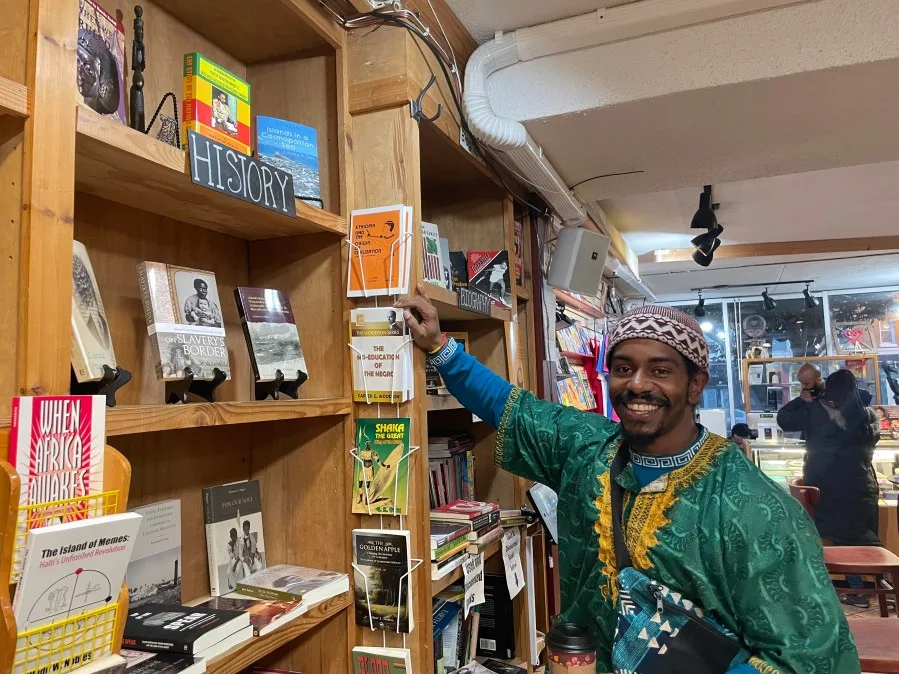WASHINGTON (DC News Now) –Businesses and historians say the Black community should be uplifted beyond Black History Month.
33-year-old Kamau Grimes says growing up in D.C. he never thought Black Americans were a minority in the U.S.

Grimes grew up in Ward 8 located in the Southernmost tip of the district east of the Anacostia River. He was born in an era when D.C. was called The Chocolate City when the 1970 census showed a city that was more than 70% Black, yet Black residents have slowly but surely been migrating from the D.C. metro area and into DMV suburbs like Prince George’s County.
According to the 2020 U.S. Census, only 41.4% of D.C.’s population identified as black alone.
As gentrification and demographic changes threaten the place of the Black community, Grimes and others are adapting to a changing community to show that they still exist- and have a rich history within this city.
Grimes says it’s disheartening to encounter so many people who move to D.C. and never meet any local.
“Obviously we want people to find [and] live their best life, chase their dreams, follow the opportunities, come to D.C.,” said Grimes. “It’s a great city, being here. But at the same time, how can we prepare the young people and the people who are from here to grow up and actually like, experience what D.C. has to offer? Because, I mean, a lot of people, they just talk about it, like, I don’t even know anyone from D.C. The only people I know from D.C. is a security guard [or a] janitor.”
Historian and African American Studies professor at Georgetown University Maurice Jackson says young citizens who move to D.C. often don’t know the history of the city they’re living in.
“In many cases, when young whites move into the area, they don’t have the consciousness that many people had years ago because many whites who came to D.C. years ago, came there directly after the civil rights movement. So, there is a level of complacency, I’m afraid,” said Jackson.
Grimes said he has found a sense of community and remembrance through Sanfoka Video Books and Cafe, where patronage turned into a job he has worked for nearly five years.
Grimes frequented Sankofa for three years before applying for a job there. He became a regular at the bookstore while completing his master’s degree at nearby Howard University after his book club recommended he source his books there.
Sankofa, which means to go back to one’s roots, has a long history of building community at its Georgia Avenue location.
The store was founded in 1998 by Haile and Shirikiana Gerima who started the business as a way to promote their eponymous film.
Grimes says Sankofa has grown to foster an environment of “intellectualism for community development.”
“You could tell the people who started this place, they weren’t necessarily just in it, they weren’t in it for the money. They’re in it for the belief, the mission, you know, ‘Is this safe space for people?’ [For] a lot of people this is their second education, they can begin the process of their own self-education…you can set your own curriculum, and it’s freeing. That’s a free place,” he said.
Briana Thomas, a Maryland-raised journalist, and historian, has worked with Sankofa to spotlight the history uncovered by her book Black Broadway, which highlights the legacies of cultural Black icons in the U-Street Corridor.
Thomas first got the idea for this book from a photo essay assignment from Washingtonian Magazine. She jumped at the opportunity to take this assignment and go back to her own roots, impassioned by childhood memories with her grandmother and sister.
“She would take me sightseeing growing up to different places or on U Street to Ben’s Chili Bowls, which is one of the remaining black-owned businesses, and a lot of those spaces aren’t around anymore or [had] just a lot of a lot of changes,” said Thomas. “There [are] a lot of factors to that, gentrification being one of them, but so many more that are so much more detailed.”
Black populations flourished in the 1960s in the areas of U-Street, Shaw, and Columbia Heights, experiencing a cultural boom in music such as jazz and go-go, literature, and activism. Thomas’ book excavates forgotten history that she and many others are fighting to preserve.
The GW Institute of Public Policy’s Center for Washington Area Studies reported that these areas have seen a decline in concentrations of Black populations.
Black citizens have been pushed toward Wards 7 and 8, which have the highest concentrations in the city.
The areas of Wards 7 and 8 have long been home to a population where the majority of its residents are Black. Wards 7 and 8 also experience the highest levels of poverty, violent crime, and unemployment.
This dates back to D.C.’s long history of segregation and redlining restricting Black residents from moving north of Florida Avenue and east of the Anacostia River, according to the DC Policy Center.
A 2020 NCRC study ranked D.C. as the 13th most intensely segregated city in the US, supported by census data from 2013 to 2017. In a study the organization did the previous year, which monitored gentrification from 2000 to 2012, DC was the number one most intensely gentrified city.
Residents have increasingly expressed frustration at this neglect of their communities until demographic change has occurred.
“For those who have been in the community and lived in the community and have seen the different eras of Washington, D.C., a lot of them don’t mind the change,” said Thomas. “The issue with the change is ‘Why do we have to leave or be pushed out because new people come?’ It’s just a matter of why does crime go down when you have more white people in a neighborhood. Why is there more police presence? Why are streets cleaner? Why do you wait until black people are no longer in their community to start having healthy food options there and having better school systems?”
Thomas said that these changing neighborhood demographics are what prompted her to invest in preserving the history of D.C.’s Black Communities and historical figures, such as Carter T. Woodson, who founded Black History Month in 1926 right in his house within the U-Street Corridor.
“Once I started researching Howard University and talking to the long-time business owners and things and they told me how the neighborhood has changed, I knew that history needed to be told and preserved. So that way, you know, more people can hopefully keep these spaces open.”
Black Broadway took form along this corridor, dominated by businesses and institutions that embodied Black culture and spirit.
She says that there have been plenty of artists keeping the spirit alive, such as the murals that decorate nearly every corner of the U-Street Corridor, paying homage to historic figures, such as Duke Ellington, Frederick Douglass, Marvin Gaye, and Chuck Brown, while also celebrating new movements and raising awareness for social change.
Jackson is also one of the editors of D.C. Jazz, a collection of stories chronicling the lives and achievements of DC’s overshadowed jazz scene, and the author of two forthcoming books on Black history.
He says looking forward, more needs to be done for his community beyond Black History Month celebrations, which often don’t do much materially.
“So African American History Month is really about the struggles, but also the achievements of African American people. One problem is, however, that this achievement, [the] struggles, need to be recognized every day, especially with the justification of the city,” Jackson said.
In Jackson’s eyes, the exodus of middle-class African Americans to the suburbs is reinforced by the city’s economic condition which stunts class mobility and jobs that increasingly require a college education.
The Washington Literacy Center estimates that for over 119,000 adults, low literacy rates act as structural barriers to escaping poverty, and a 2017 report that Jackson helped author envisioned half of all new jobs in D.C. by 2020 would require at least a bachelor’s degree.
Jackson believes that more needs to be done to bridge this gap and sustainably retain D.C.’s Black population. Black community efforts have always existed, according to Jackson, but they lack the resources and the funds, so responsibility ultimately lands on the government.
“It’s not just that people are leaving,” Jackson said. It’s that no one cares that people are leaving. It’s that so many African Americans are leaving the city because of economics, and few people are doing anything to try to help.”
Looking to the end of Black History Month, the struggles that Black Americans in D.C. face are clear, but the community champions resilience in the face of it.
Businesses and historians are working hand in hand to preserve their culture’s presence in the city and memorialize the history they built, and they urge residents of D.C. to widen the scope of their investment beyond this month and stand by the Black community year-round.
“To help preserve history, you have to support the storytellers of history and you also have to support the establishments. So especially during Black History Month, but all days of the year support black businesses, support theaters that support black people, support black art, support black writers. That’s how you help to preserve the history because you’re preserving the culture,” Thomas said.
Recommended Reading for furthering knowledge:
- Black Broadway in Washington, D.C. by Briana Thomas
- DC Jazz: Stories of Jazz Music in Washington, DC edited by Maurice Jackson and Blair A. Ruble
- Chocolate City: A History of Race and Democracy in the Nation’s Capital by Chris Myers Asch and George Derek Musgrove
- Hidden Alleyways of Washington, D.C.: A History, by Kim Prothro Williams
- Barry Farm-Hillsdale in Anacostia: A Historic African American Community (American Heritage) by Alcione M. Amos
- Egypt on the Potomac by Anthony T. Browder
- Mayor for Life: The Incredible Story of Marion Barry, Jr. by Marion Barry Jr. and Omar Tyree
- Lost in the City by Edward P. Jones


